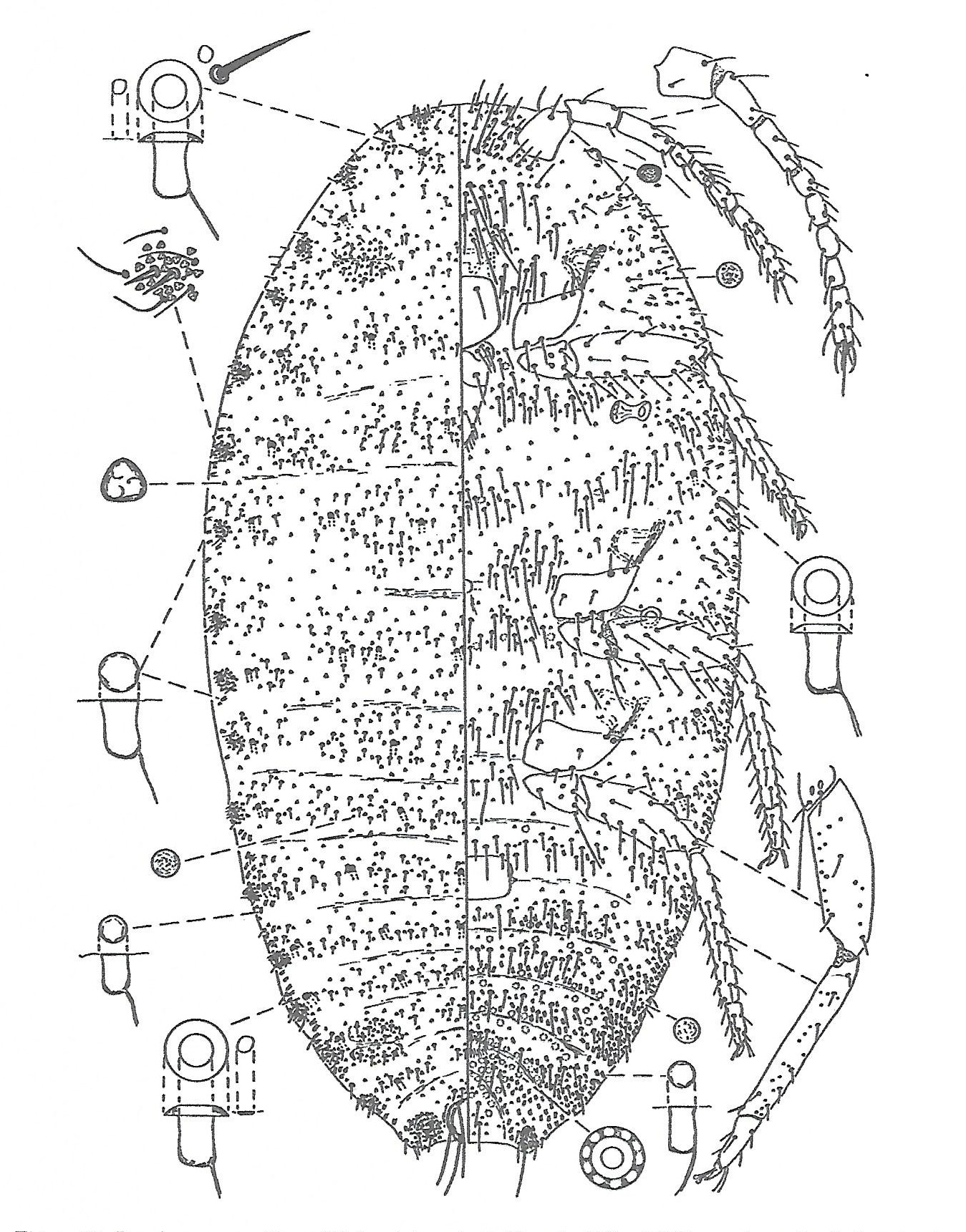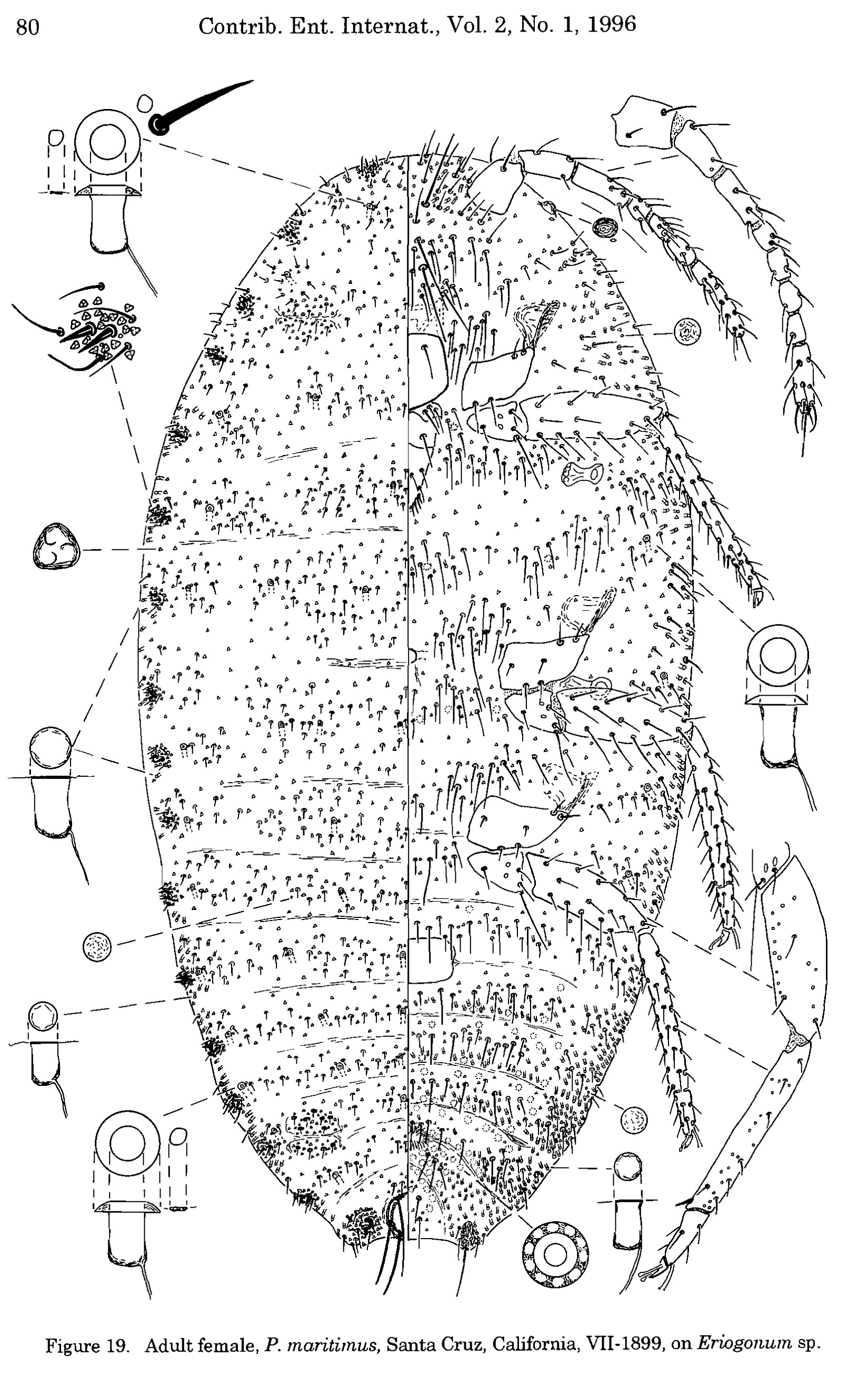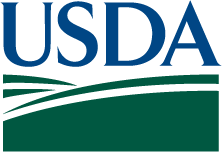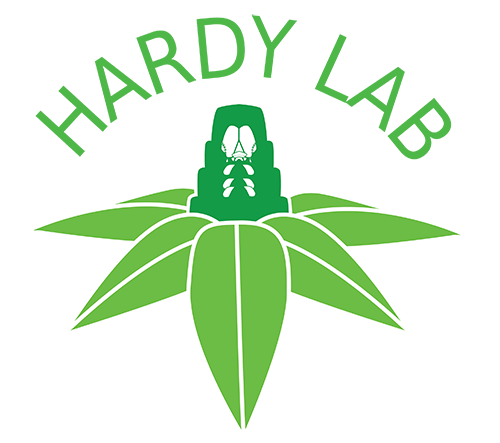Valid Names Results
Pseudococcus maritimus (Ehrhorn, 1900) (Pseudococcidae: Pseudococcus)Nomenclatural History
- Dactylopius maritimus Ehrhorn 1900: 316. Type data: U.S.A.: California, Santa Cruz, on roots of Eriogonum latifolium. Lectotype, female, by subsequent designation (MillerGiWi1984,710). Type depository: Washington: United States National Entomological Collection, U.S. National Museum of Natural History, District of Columbia, USA; accepted valid name
- Pseudococcus bakeri Essig 1910c: 341. Type data: U.S.A.: California, Ventura County, on walnut [= Juglans regia]. Lectotype, female, by subsequent designation (MillerGiWi1984,710). Type depository: San Francisco: California Academy of Sciences, Department of Entomology, California, USA; junior synonym (discovered by Ferris1950, 187).
- Pseudococcus omniverae Hollinger 1917a: 271. Type data: U.S.A.: Missouri, Boone County, near Columbia, on Tilia americana.. Syntypes, female, by subsequent designation Type depository: Washington: United States National Entomological Collection, U.S. National Museum of Natural History, District of Columbia, USA; junior synonym (discovered by Ferris1918d, 48).
- Pseudococcus maritimus (Ehrhorn, 1900); Ben-Dov 1994: 401. change of combination
Common Names
- American grape mealybug McKenz1967
- Baker's mealybug Essig1915a
- canchitos blancos de la uva de mesa Gonzal1983RH
- cotonet maritimo Lloren1990
- grape mealybug Bartle1978e GimpelMi1996 Koszta1996 McKenz1967
- ocean mealybug Betrem1937
- cochinilla harinosa de la vid WatsonKo2022
Ecological Associates
Hosts:
Families: 53 | Genera: 92
- Adoxaceae
- Sambucus | GimpelMi1996
- Sambucus nigra | BenDov1994 Essig1910b | (= Sambucus glauca)
- Aizoaceae
- Mesembryanthemum | BenDov1994 McKenz1967
- Altingiaceae
- Liquidambar styraciflua | GimpelMi1996
- Amaranthaceae
- Alternanthera | BenDov1994 Granar1991a
- Alternanthera pungens | BenDov1994 WilliaGr1992
- Amaryllidaceae
- Haemanthus | BugajNJuKa2021
- Narcissus | BenDov1994 GimpelMi1996 McKenz1967
- Anacardiaceae
- Cyrtocarpa edulis | BenDov1994 Ferris1950b
- Toxicodendron diversilobum | BenDov1994 McKenz1967
- Annonaceae
- Annona | BenDov1994 WilliaGr1992
- Aquifoliaceae
- Ilex vomitoria | GimpelMi1996
- Araceae
- Aglaonema | JansenAl2023
- Zantedeschia | BenDov1994 McKenz1967
- Araliaceae
- Schefflera arboricola | GoszczGo2011
- Asphodelaceae
- Aloe | BugajNJuKa2021
- Asteraceae
- Ericameria ericoides | BenDov1994 McKenz1967 | (= Haplopappus ericoides)
- Erigeron | BenDov1994 Betrem1937
- Parthenium | BenDov1994 Granar1991a WilliaGr1992
- Solidago sempervirens | BenDov1994 HodgsoHi1990 HodgsoHi1991 WilliaGr1992
- Berberidaceae
- Berberis aristata | GimpelMi1996 GimpelMi1996 | (= Berberis compacta gracilis),(= Berberis compacta gracilis)
- Betulaceae
- Corylus americana | GimpelMi1996
- Ostrya virginiana | GimpelMi1996
- Bignoniaceae
- Catalpa | BenDov1994 McKenz1967
- Cactaceae
- Opuntia | BugajNJuKa2021
- Cannabaceae
- Celtis | BenDov1994 McKenz1967
- Celtis occidentalis | GimpelMi1996
- Convolvulaceae
- Ipomoea | BenDov1994 Granar1991a
- Cornaceae
- Cornus florida | GimpelMi1996
- Cupressaceae
- Cupressus | BenDov1994 McKenz1967
- Juniperus maritima | GimpelMi1996
- Thuja | GimpelMi1996
- Cyperaceae
- Cyperus | BenDov1994 Granar1991a
- Ebenaceae
- Diospyros | GimpelMi1996
- Ericaceae
- Arbutus | BenDov1994 McKenz1967
- Calluna vulgaris | BugajNJuKa2021
- Erica lusitanica | Stalaz2021
- Rhododendron | GimpelMi1996
- Rhododendron maximum | GimpelMi1996
- Vaccinium | GimpelMi1996
- Euphorbiaceae
- Manihot esculenta | BenDov1994 WilliaGr1992
- Fabaceae
- Albizia julibrissin | BenDov1994 TerGri1954 | (= Acacia julibrissin)
- Astragalus | GimpelMi1996
- Genista | BenDov1994 McKenz1967
- Gleditsia triacanthos | BenDov1994 McKenz1967
- Medicago sativa | BenDov1994 WilliaGr1992
- Psoralea macrostachya | BenDov1994 McKenz1967
- Robinia | GimpelMi1996
- Trifolium | BenDov1994 WilliaGr1992
- Gentianaceae
- Eustoma grandiflorum | GimpelMi1996 | (= Eustoma russellianum)
- Juglandaceae
- Carya | GimpelMi1996
- Juglans regia | BenDov1994
- Lamiaceae
- Salvia mellifera | BenDov1994 McKenz1967 | (= Ramona stachyoides)
- Lauraceae
- Laurus nobilis | Stalaz2021
- Persea | GimpelMi1996
- Sassafras | GimpelMi1996
- Umbellularia californica | BugajNJuKa2021
- Magnoliaceae
- Magnolia | BenDov1994 Betrem1937
- Malvaceae
- Abutilon pictum | GoszczGo2011 | (= Abutilon striatum)
- Anoda cristata | BenDov1994 WilliaGr1992
- Anoda hastata | GranarGo2018
- Callianthe striata | GoszczGo2011
- Tilia americana | BenDov1994 GimpelMi1996 McKenz1967
- Moraceae
- Ficus | Stalaz2021
- Ficus benjamina | JansenAl2023
- Ficus elastica | BugajNJuKa2021
- Maclura | GimpelMi1996
- Morus | BenDov1994 McKenz1967
- Myrtaceae
- Myrtus communis | Stalaz2021
- Nyctaginaceae
- Boerhavia | BenDov1994 WilliaGr1992 BenDov1994 WilliaGr1992
- Oleaceae
- Fraxinus caroliniana | GimpelMi1996
- Orchidaceae
- Chysis aurea | GimpelMi1996
- Rossioglossum grande | BenDov1994 Ferris1950b | (= Odontoglossum grande)
- Passifloraceae
- Passiflora auriculata | GoszczGo2011
- Passiflora quadrangularis | GoszczGo2011
- Plantaginaceae
- Bacopa | JansenAl2023
- Platanaceae
- Platanus | GimpelMi1996
- Polygonaceae
- Eriogonum | GimpelMi1996
- Eriogonum latifolium | BenDov1994 Ehrhor1900 Essig1909a
- Polygonum | GimpelMi1996
- Proteaceae
- Grevillea | BenDov1994 Essig1915a
- Rhamnaceae
- Ceanothus | BenDov1994 McKenz1967
- Rosaceae
- Cotoneaster | GimpelMi1996
- Cydonia | GimpelMi1996
- Malus | GimpelMi1996
- Malus sylvestris | BenDov1994
- Prunus | BenDov1994 McKenz1967
- Prunus tomentosa | GimpelMi1996
- Pyrus | GimpelMi1996
- Pyrus communis | BenDov1994 Ferris1950b Granar1991a WilliaGr1992
- Rubus vitifolius | BenDov1994 McKenz1967
- Rubiaceae
- Coffea arabica | BugajNJuKa2021
- Spermacoce | GimpelMi1996
- Rutaceae
- Citrus | BenDov1994 Ferris1950b
- Citrus japonica | BatsanKaKi2017
- Citrus limon | BatsanKaKi2017
- Citrus maxima | GoszczGo2011 | (= Citrus grandis)
- Toddalia asiatica | Stalaz2021
- Sapindaceae
- Acer | GimpelMi1996
- Acer saccharinum | GimpelMi1996
- Solanaceae
- Cestrum | BenDov1994 Granar1991a
- Solanum melongena | MatileEt2006
- Solanum quitoense | JansenAl2023
- Strelitziaceae
- Strelitzia | BenDov1994 McKenz1967
- Taxaceae
- Taxus | GimpelMi1996
- Taxus baccata | GimpelMi1996 | (= Taxus adpressa)
- Theaceae
- Camellia | Stalaz2021
- Ulmaceae
- Ulmus | GimpelMi1996
- Verbenaceae
- Duranta erecta | BugajNJuKa2021
- Vitaceae
- Vitis | BenDov1994 Gonzal1983RH McKenz1967
- Vitis vinifera | PalmaJBl2016
Foes:
Families: 8 | Genera: 26
- Aphelinidae
- Coccophagus gurneyi | Blumbe1997
- Chamaemyiidae
- Leucopis | GaimarGoEl2024
- Leucopis cortesi | GaimarGoEl2024
- Chrysopidae
- Chrysopa oculata | WatsonKoLa2022
- Chrysoperla carnea | WatsonKoLa2022 | (= Chrysopa carnea)
- Chrysoperla plorabunda | DouttHa1950 | (= Chrysopa californica)
- Coccinellidae
- Coccinella transversoguttata | WatsonKoLa2022
- Encyrtidae
- Acerophagus angelicus | WatsonKoLa2022
- Acerophagus notativentris | FlaherJePe1982
- Acerophagus pallidus | WatsonKoLa2022
- Acerophagus websteri | WatsonKoLa2022
- Aenasius masii | WatsonKoLa2022
- Aenasius paulistus | Comper1937a
- Anagyrus clauseni | WatsonKoLa2022
- Anagyrus yuccae | FlaherJePe1982
- Blepyrus saccharicola | WatsonKoLa2022
- Bothriocraera bicolor | WatsonKoLa2022
- Chrysoplatycerus splendens | WatsonKoLa2022
- Coccidoxenoides perminutus | WatsonKoLa2022
- Ericydnus lamasi | WatsonKoLa2022
- Holcencyrtus myrmicoides | WatsonKoLa2022
- Leptomastidea abnormis | WatsonKoLa2022
- Leptomastix dactylopii | Blumbe1997
- Mayridia | WatsonKoLa2022
- Prochiloneurus | GilCoMa2023
- Prochiloneurus dactylopii | WatsonKoLa2022
- Pseudleptomastix squammulata | FlaherJePe1982
- Subprionomitus | WatsonKoLa2022
- Tetracnemoidea brevicornis | WatsonKoLa2022
- Tetracnemoidea peregrina | WatsonKoLa2022
- Zaplatycerus melvillei | WatsonKoLa2022
- Zarhopalus corvinus | FlaherJePe1982
- Zarhopalus sheldoni | WatsonKoLa2022
- Eulophidae
- Aprostocetus minutus | WatsonKoLa2022
- Pyralidae
- Cacotherapia unipuncta | SalasMGoCo2022
- Signiphoridae
- Chartocerus elongatus | WatsonKoLa2022
- Chartocerus subaeneus | RosenArWo1992
Associates:
Families: 2 | Genera: 1
- Closteroviridae
- GLRaV-1 | FuchsMaHe2015
- GLRaV-3 | BahderPoAl2013
- Closterovirus
- LChV-2 | MekuriSmBe2013
Geographic Distribution
Countries: 27
- Argentina
- Mendoza | BenDov1994 Granar1991 WilliaGr1992
- Salta | BenDov1994 Granar1991
- Tucuman | BenDov1994 Granar1991
- Armenia | BenDov1994 TerGri1954
- Bermuda | BenDov1994 HodgsoHi1990 HodgsoHi1991 WilliaGr1992
- Brazil | BenDov1994 Ferris1950b WilliaGr1992
- Bulgaria | TrenchTo2014 Tsalev1968
- Canada | BenDov1994 McKenz1967
- Canary Islands | JansenAl2023
- Chile | BenDov1994 Gonzal1983RH WilliaGr1992
- Colombia | Figuer1952
- Easter Island (=Rapa Nui) | WynneHoCo2025
- French Guiana | WatsonKoLa2022
- Georgia (Republic of) | BatsanKaKi2017
- Germany | JansenAl2023
- Guadeloupe | MatileEt2006
- Guatemala | BenDov1994 Ferris1950b WilliaGr1992
- Guiana | BenDov1994 WilliaGr1992
- Hawaiian Islands | Suehir1937
- Iceland | GeroAlSz2025
- Indonesia
- Java | BenDov1994 Betrem1937
- Latvia | Stalaz2021
- Madeira Islands | FrancoRuMa2011
- Mexico | BenDov1994 Ferris1950b
- Netherlands | JansenAl2023
- Poland | BenDov1994 Koteja1974b
- Puerto Rico & Vieques Island
- Puerto Rico | Martor1976
- Puerto Rico | WatsonKoLa2022
- Suriname | JansenAl2023
- United States
- Arkansas | GimpelMi1996
- California | BenDov1994 Ehrhor1900 Essig1909a Essig1915a FlaherJePe1982 GimpelMi1996 McKenz1967
- Connecticut | GimpelMi1996
- Delaware | BenDov1994 McKenz1967
- District of Columbia | GimpelMi1996
- Florida | GimpelMi1996
- Georgia | GimpelMi1996
- Illinois | GimpelMi1996
- Indiana | GimpelMi1996
- Iowa | GimpelMi1996
- Maryland | GimpelMi1996
- Massachusetts | GimpelMi1996
- Michigan | GimpelMi1996
- Missouri | BenDov1994 GimpelMi1996 Hollin1917
- New Hampshire | GimpelMi1996
- New Jersey | BenDov1994 McKenz1967
- New York | GimpelMi1996
- Ohio | BenDov1994 GimpelMi1996 McKenz1967
- Oregon | BenDov1994 McKenz1967
- Pennsylvania | GimpelMi1996
- Rhode Island | GimpelMi1996
- Tennessee | GimpelMi1996
- Texas | BenDov1994 GimpelMi1996 McKenz1967
- Vermont | GimpelMi1996
- Virginia | GimpelMi1996
- Washington | BenDov1994 DownieGu2004 GimpelMi1996 McKenz1967
- West Virginia | GimpelMi1996
Keys
- ZarkanWaKa2024: pp.596 ( Adult (F) ) [Pseudococcus in Southeast and southern Asia]
- EvansAb2023: pp.8-13 ( Adult (F) ) [Pseudococccidae of Egypt]
- Suh2019a: pp.2-6 ( Adult (F) ) [mealybugs intercepted in S. Korea]
- GranarGo2018: pp.10-14 ( Adult (F) ) [Central & South American Pseudococcus]
- LiLiWa2018: pp.538-539 ( Adult (F) ) [Species of Pseudococcus]
- VonEllWa2016: pp.74-75 ( Adult (F) ) [Pseudococcus species present in the New World]
- ParsaKoWi2012: pp.10-Aug ( Adult (F) ) [Key to mealybugs (Hemiptera: Pseudococcidae) recorded on Manihot spp. (Euphorbiaceae) in the World]
- GranarDu2012: pp.35 ( Adult (F) ) [Pseudococcus affecting forage crops]
- WangWu2010: pp.245 ( Adult (F) ) [Key to the species of Pseudococcus from China (in Chinese)]
- GimpelMi1996: pp.20 ( Adult (F) ) [World]
- GimpelMi1996: pp.137 ( Immature (F) ) [World]
- Koszta1996: pp.184 ( Adult (F) ) [Northeastern North USA]
- Tang1992: pp.235 ( Adult (F) ) [China]
- WilliaGr1992: pp.427 ( Adult (F) ) [Central and South America]
- McKenz1967: pp.289 ( Adult (F) ) [U.S.A., California]
- Beards1966: pp.457 ( Adult (F) ) [Federated States of Micronesia]
- McKenz1964: pp.256 ( Adult (F) ) [North America]
- McKenz1962: pp.655 ( Adult (F) ) [North America]
- Beards1960: pp.212 ( Adult (M) ) [Hawaii]
- McKenz1960: pp.725 ( Adult (F) ) [North America]
- Ferris1953a: pp.418 ( Adult (F) ) [North America]
- Ferris1950b: pp.173 ( Adult (F) ) [North America]
- Borchs1949: pp.92 ( Adult (F) ) [Palaearctic region]
- Zimmer1948: pp.177 ( Adult (F) ) [Hawaii]
- Borchs1947b: pp.2110 ( Adult (F) ) [P. comstocki group of species]
Remarks
- Systematics: Pseudococcus affinis has been frequently misidentified as P.maritimus, leading to numerous records of the latter species from throughout the world.
- Structure: Colour photograph given by McKenzie (1967) and by Gonzalez (1983; 1983a). Munson et al. (1992) studied the relationship of endosymbionts of this mealybug, of P. longispinus, of D. neobrevipes and of aphids, and concluded that those of the mealybugs are related and phylogenetically are distinct from those of aphids.
- Biology: In California it develops two annual generations, and overwintering takes place in ovisac or as first instar crawlers. Feeding and injury are primarily on leaves, but adult females migrate to the trunk for oviposition (Flaherty et al., 1982). Grimes & Cone (1985) provided data on the life history and biology. Natural enemies discussed by Bartlett (1978) and by Grimes & Cones (1985). The effect of natural enemies on pupulation dynamics in Washington (USA) was studied by Grassawitz & Burts (1995). Life history studies were made of Pseudococcus maritimus (Ehrhorn) reared in the laboratory on potato sprouts at a LD 16:8 photoperiod and ca. 24C. The female mealybug had three larval instars while the male had four. Stadia were determined for all stages except the egg and first instar . Average number of eggs produced was 57.0 (n=38). Larger females (length in mm) produced more eggs than smaller females (P< 0.001, n=20). Mating was necessary for egg production. Five pheromone traps were placed in a Concord grape vineyard in August 1983 during adult male emergence: three were baited with 10 P. maritimus virgin females each; two raps were not baited. The baited traps collected 98.5% of all trapped males, suggesting that mature virgin female grape mealybugs produce a male attractant. Natural enemies of the grape mealybug were collected as they were encountered in the field. These included a parasite, Pseudaphycus angelicus (Howard), and a hyperparasite, Pachyneuron sp. Larvae of Chrysopa carnea Stephens and C. oculata Say preyed on early instars of grape mealybugs occuring under rough bark of the grape vine. In mid-August 1981 and 1982, adults of Coccinella transversoguttata Faldemnann were observed in the vineyard feeding on mealybugs on grape clusters. (Grimes & Cone, 1985). The emergence of males from their cocoons and the longevity of males were minimally affected by the presence or absence of the sex pheromone. Because Ps. maritimus cannot reproduce asexually, unmated females in areas treated with pheromone for disruption of mating could not reproduce and compromise the efficacy of pheromone-based control. Second, males of Ps. maritimus live for several days and are capable of mating numerous times over multiple days, so that pheromone coverage would have to be continuous and robust for extended periods when males were active to be effective. In addition, unmated female mealybugs can live for several months, further increasing the requirements for continuous pheromone coverage to prevent males from finding them. (Watersworth & Millar, 2012)
- Economic Importance: As indicated above it is a polyphagous species, however, it has been reported in California mainly as a pest of grape, pear and apricot (Bartlett, 1978; Flaherty et al., 1982) Chemigation is the preferable means to control Ps. maritimus in vineyards because it does not disrupt populations of natural enemies that are effective at keeping Ps. maritimus populations low and it targets all feeding instars. (Bahder, et al., 2013) Symptoms are not a reliable indicator of the presence or absence of GLRaV-3. Interveinal discoloration and curly leaves can be caused by factors that are not related to infection by GLRaV-3 such as nutrient deficiencies, environment, and other diseases. Conversely, asymptomatic vines may also be infected by GLRaV-3. The choice and timing of applications of insecticide is critical for mealybug control, and systemic insecticides applied in-season (early summer) as a foliar application showed promising results on mealybugs control. (Jones & Nita, 2016) Prior to being identified as a vector of GLRaVs, P. maritimus was considered a nuisance pest in Washington State vineyards when honeydew excretions from feeding would cause sooty mold to develop on fruit clusters. O'Hearn & Watson, 2021 confirmed an extremely low economic threshold for P. maritimus in the presence of GLRaV-3 infected vines. They found a transmission rat of 65% with 10 P. maritimus crawlers that were transferred from an infected to an uninfected vine.
- General Remarks: Description and illustration of the adult female given by Ferris in Zimmerman (1948), Ferris (1950b), McKenzie (1967), Williams & Granara de Willink (1992) and by Gimpel & Miller (1996). Good description and illustration of the third instar female given by Gimpel & Miller (1996). Good description of the adult female, first-instar nymph, female second-instar nymph and female third-instar nymph given by Borchsenius (1949). Good description and illustration of the adult male given by Beardsley (1960). Pseudococcus affinis has been frequently misidentified as P. maritimus, leading to numerous records of the latter species from throughout the world. In fact, P. maritimus appears to be confined to the New World. Williams & Granara de Willink (1992: 456) erroneusly stated that this mealybug is common in Australia, however it has not been recorded from that continent. Therefore, the CABI (1980) distribution map of this species should be revised. Kondo et al. (2008) indicated that this species had not been recordedvin Colombia since the report by Figueroa (1952), and there are no voucher specimens available to verify this record. (Caballero, et al., 2021)
Illustrations
Citations
- Aldric1996: chemical ecology, chemistry, life history, physiology, 205-206
- AlmeidDaBe2013: Grapevine leafroll disease transmission, 3
- AltierNi1999: biological control, 975-991
- Armita1919: biological control, 257-260
- AroraClWe2020: control,
- BahderPoAl2013: chemical control, economic importance, host, molecular data, taxonomy, 1292-1298
- Bartle1969: biological control, 975-878
- Bartle1978e: biological control, distribution, economic importance, host, 166-168
- BartleLl1958: distribution, economic importance, host, 90-93
- BatsanKaKi2017: distribution, host, 265
- Beards1960: description, distribution, host, illustration, taxonomy, 230-231
- BeltraGaSo2013: 1492
- BenDov1994: catalog, 401-402
- Betrem1937: description, distribution, host, illustration, taxonomy, 40, 41
- Blumbe1997: biological control, ecology, 225-236
- Borchs1937a: description, distribution, host, illustration, taxonomy, 161, 162
- Borchs1949: description, distribution, host, life history, taxonomy, 102-107
- Boyce1948: control, distribution, economic importance, host,
- Branig1916: biological control, 304-306
- Brock1925: economic importance, 349,366
- BuangAmAd2025: molecular biology, 10
- BugajNJuKa2021: distribution, host, list, 311
- CaballPaKa2021: distribution, morphology, 8, 10
- Cendan1937: biological control, 337-339
- Chaffi1923b: distribution, economic importance, host, illustration, record,
- Clause1924: biological control, economic importance, life history, 252-265
- Comper1937a: biological control, distribution, host, 402-403
- Comper1939: biological control, 57-73
- Cook1915: control,
- CooperDaJe2018: Grapevine leafroll disease transmission, 1-9
- CorreaAgGe2011: distribution, host, taxonomy, 46
- CottieHaJa1952: chemical control, distribution, host, 266-276
- DaaneCoTr2008a: biological control, distribution, 167-171
- DaaneMaGu2003: biological control, 389-398
- DaaneSiFa2007: biological control, distribution, host, life history, 583-596
- DavidsDiFl1991: chemical control, 1-47
- Doutt1949: structure, taxonomy, 835
- Doutt1952: structure, taxonomy, 391-397
- DouttHa1950: biological control, distribution, host, 94-96
- DowellGiJe2016: distribution, 119
- DownieGu2004: distribution, host, molecular data, phylogeny, 258-259
- DunleyMi1996: biological control, distribution, host, 656
- Ehrhor1900: description, distribution, host, illustration, taxonomy, 316, 317
- Essig1909a: distribution, host, 36
- Essig1910c: taxonomy, 341
- Essig1915a: description, economic control, host, life history, taxonomy, 126
- EvansAb2023: distribution, host, illustration, key, taxonomy, 6, 9, 24, 70
- EzzatNa1987: distribution, 89
- Ferris1918d: description, distribution, host, illustration, taxonomy, 48-49
- Ferris1950b: description, distribution, host, illustration, taxonomy, 187-188
- FerrisMu1936: structure, taxonomy, 115-122
- Figuer1952: distribution, host, 207
- FlaherJePe1982: biological control, description, economic importance, taxonomy, 160-164
- FlaherPeBe1982: chemical control, distribution, economic importance, host, 15-16
- FlaherPhLe1992: biological control, distribution, economic importance, host, 159-165
- FlaherWi1999: biological control, 853-869
- FlaherWiSt1985: biological control, 501-520
- FrancoCoLu2021: reproduction, 254
- FrancoRuMa2011: distribution, host, 2,21,25
- FuchsMaHe2015: Grapevine leafroll disease transmission, 503-510
- GaimarGoEl2024: host, natural enemies, 561
- Gavril2018: morphology, 208
- GeigerDa2001: distribution, ecology, economic importance, host, life history, 291-301
- GeigerDaBe2001: distribution, ecology, economic importance, host, life history, 19-27
- GermaiDeLa2016: host, list of species, 4
- GeroAlSz2025: distribution, history, list, 124
- GimpelMi1996: description, distribution, host, illustration, taxonomy, 79-83, 147-149
- GiurcaToMu2024: control, 311
- GontijToAb2025: biological control, ecology, history, natural enemies, 3
- Gonzal1983RH: chemical control, description, distribution, economic importance, host, illustration, life history, taxonomy, 44-50
- Gonzal1983aRH: chemical control, distribution, economic importance, host, life history, 3-7
- Gonzal1991: chemical control, distribution, economic importance, host, life history, 3-7
- Gonzal2003a: distribution, economic importance, host, 89-98
- Gonzal2008a: distribution, economic importance, host, 5-17
- Gonzal2016: diagnosis, distribution, 235, 238, 243-245, 251-253
- GonzalVo2004: distribution, economic importance, host, 41-62
- GoszczGo2011: distribution, host, 110-111
- GranarDu2012: key, 35
- GranarGo2018: diagnosis, distribution, illustration, key, taxonomy, 6, 10-14, 34
- GrasswJa2008: disease transmission, distribution, ecology, economic importance, host, life history, 268-275
- Green1920: description, distribution, host, illustration, taxonomy, 121, 122
- GrimesCo1985: biological control, ecology, life history, 554-558
- GrimesCo1985a: chemical control, 3-6
- HansenHeNe2006: control, 221-229
- HardyGuHo2008: molecular data, phylogeny, taxonomy, 51-71
- HerrbaAlPr2017: Grapevine leafroll disease transmission, 483-503
- Hollin1917a: taxonomy, 271
- Hollin1923: description, taxonomy, 55
- HommayAlBe2025: GLRV, GVA virus, Grapevine leafroll disease transmission, 5
- HoyHe1985: biological control,
- JansenAl2023: dispersal, host, 30,36
- JensenStBr1954: chemical control, distribution, economic importance, host, 11
- JonesNi2016: GLRV, control, disease transmission, host, virus, virus transmission, 885–900
- JonesRaNi2015: GLRV, Grapevine leafroll disease transmission,
- Kondo2001: distribution, host, taxonomy, 38
- Koszta1996: biological control, description, distribution, economic importance, host, illustration, life history, taxonomy, 184-186
- Koteja1974b: distribution, taxonomy, 74
- Lagows1995a: biological control, economic importance, 375-378
- LagowsGo2020: distribution, 70
- LiShWe2025: behavior, natural enemies, 7
- Lloyd1958: biological control, 450-468
- MacDonScCo2021: Grapevine leafroll disease transmission, control, ecology,
- MacPheCaVa1976: biological control, 337-358
- MadsenWe1962: chemical control, ecology, life history, 849-850
- MadsenWo1964: chemical control, 281-283
- MarottTr1995a: taxonomy, 70-71
- Martor1976: distribution, host, 11,255
- MarzoBVaNa2024: chemical, reproductive system, 21488
- MatileEt2006: distribution, host, 183
- McDaniGaMo2024: control,
- McKenz1967: description, distribution, host, illustration, taxonomy, 306-309
- McLeod1962: biological control, distribution, economic importance, host, 1-33
- MekuriSmBe2013: economic importance, illustration, molecular data, 851
- MercerHaDa2025: ant association, 6
- MetcalMe1993: control, distribution, economic importance, host,
- Meurge2011: distribution, 82
- MillerGiWi1984: description, distribution, host, illustration, taxonomy, 708-711
- MoranBaDo1994: molecular data, phylogeny, symbionts, 79-83
- MorettSc2025: biological control, distribution, host, natural enemies,
- MunsonBaMo1992: structure, 26-30
- Myers1922: 198
- NRC1969: biological control, chemical control, ecology, economic importance, taxonomy,
- NamadaUtRa2025: GLRV, control, host, reproduction, vector, 3, 7
- Neiswa1949: chemical control, distribution, economic importance, host, 41-44
- Nougar1918: distribution, economic importance, host, life history, 511-514
- OHearnWa2018: host, illustration, life cycle, 993-995
- OHearnWa2021: GLRV, economic importance,
- OnayemRiBa2025: Grapevine leafroll disease transmission, chemical control, economic importance, life cycle, nymph,
- OrdoghTa1983: chemical control, 417-419
- OuvrarKoGu2013: biological control, economic importance, 2
- OzodbeKhKo2024: molecular biology, phylogenetics, 3
- PachecBeBl2014: distribution, economic importance, host, life history, phylogeny, 1-13
- PalmaJBl2015: SEM,
- PalmaJBl2016: host, phylogeny, 126-128, 130-132
- PalmaJBlGu2019: distribution,
- ParsaKoWi2012: taxonomy, 9
- PoojarBoDe2017: GLRV, Grapevine leafroll disease transmission, 2088-2097
- PoornaSiMu2025: history, importance,
- RenAsHu2017: DNA, phylogeny, 5, 6
- RosenArWo1992: biological control, life history, 241-253
- RossHaOk2012: phylogeny, taxonomy, 199
- Sassce1911: 64
- SchulzBeJa2025: dispersal, distribution, economic importance, host, virus, 322
- ShanLiLi2026: fumigation, life cycle, 2, 7
- Smith1917a: biological control, distribution, host, 108-114
- Smith1958: chemical control, distribution, host, 335-338
- SmithFl1950: biological control, 362, 376, 378
- Stalaz2021: distribution, host, 476
- Suehir1937: distribution, host,
- Suh2019a: key, 3
- Sweetm1958: biological control, economic importance, 449-458
- Tao1999: distribution, host, taxonomy, 26
- TatePo1937: distribution, host, 1-20
- TerGri1954: biological control, description, distribution, host, taxonomy, 62
- TippinBiCh2003: chemical control, 246-250
- TrenchTo2014: distribution, 66, 67
- TsaiRoGo2010: vector, virus transmission,
- TurnbuCh1961: biological control, distribution, host,
- UneliuElTw2011: molecular data, 170
- VeaGr2015: phylogeny, 64
- VeaGr2016: evolution, 4
- VonEll2025: distribution, 33
- VonEllWa2016: key, 75
- WangZhTi2018: genebank, phylogeny,
- WaterwMi2012: biological control, life history, 949-956
- WatsonKoLa2022: biology, control, diagnosis, distribution, host, illustration, natural enemies, taxonomy, 202-203
- Willia2017a: catalog, list of species, 245
- Willia2017a: catalog, list of species, 248
- WilliaBe2015: taxonomy, 165
- WilliaGr1992: description, distribution, host, illustration, taxonomy, 454-456
- WilliaMa2012: distribution, host, 90
- WynneHoCo2025: distribution, list of species, 19
- XieXuLi1995: distribution, economic importance, host, 115-118
- YangLiXu2008: distribution, host, key, 279, 280
- YokoyaMiCr2001: chemical control, ecology, economic importance, life history, 984-988
- ZarkanApTu2021: distribution, host, 186
- ZarkanWaKa2024: distribution, key, 591, 596
- Zimmer1948: description, distribution, host, illustration, taxonomy, 177, 222-225
- ZouChMi2013: biological control, chemistry, economic importance, 131-133




